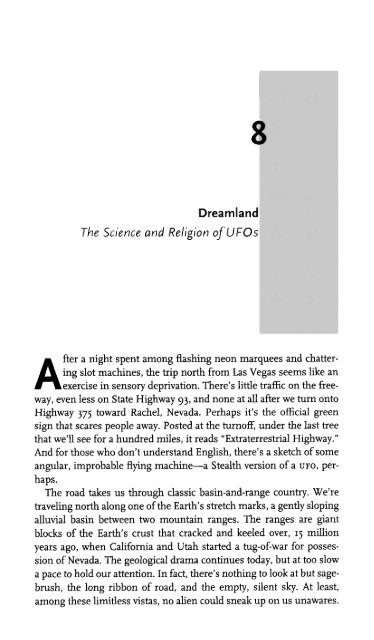Create successful ePaper yourself
Turn your PDF publications into a flip-book with our unique Google optimized e-Paper software.
HERE BE DRAGONS<br />
Milky Way, our home galaxy. Its 300 billion stars merge into a broad<br />
river of light. Just a minute fraction of them, that happen to be close to<br />
us, form the myriad sparkling points that we call "the stars," yet even<br />
these few seem numberless. It's hard to doubt that, on a planet orbiting<br />
one of those stars, a living creature is gazing back at us.<br />
To tell whether any of the stars really do have planets, and whether<br />
any of these planets are inhabited, seemed for centuries an impossible<br />
task. Even today, the world's greatest telescopes, such as the Hale telescope<br />
at Palomar, the twin Keck telescopes on Hawaii, and the Hubble<br />
Space Telescope, are incapable of spotting planets around other stars:<br />
not because the planets are too faint, necessarily, but because they<br />
cling too close to their bright parent stars. Yet a series of brilliant innovations<br />
has allowed astronomers to detect a handful of such planets<br />
indirectly and even to describe their basic properties, such as their size<br />
and orbital characteristics, as we'll describe in the next chapter.<br />
Even more exciting than the detection of extrasolar planets, though,<br />
is our dawning understanding of the evolution of stars and their planetary<br />
systems, an evolution that may carry the seeds of life from the<br />
very beginning, even before a star and its planets are formed. Not<br />
many years ago, it was possible to believe that our Sun, with its nine<br />
planets—at least one of them inhabited—was a freak that might not<br />
be repeated within our galaxy. Now, though many details remain unresolved,<br />
we can speak of the birth of stars and their planets as one of<br />
the fundamental processes of the cosmos, and we can tentatively explain<br />
how the chemical building blocks of life take part in this process,<br />
making an extraordinary journey from deep space to end up in living<br />
creatures such as ourselves.<br />
As we look up into the night sky, the winter constellation of Orion<br />
dominates the scene. The mighty hunter, followed by his dogs (Canis<br />
Major and Minor), chases Taurus the bull eternally westward. Orion<br />
straddles the celestial equator—the circle, oblique to the ecliptic,<br />
which lies directly over the equator of the Earth. Almost everyone recognizes<br />
this dramatic constellation and its brilliant individual stars<br />
with their exotic names: <strong>Be</strong>telgeuse, the variable red giant in Orion's<br />
shoulder; <strong>Be</strong>llatrix, in Orion's other shoulder; and the blue-white giant<br />
Rigel, the sixth brightest star in the sky, in Orion's foot. Most striking,<br />
though, are the three close-set stars that form Orion's belt and the<br />
fainter line of stars that dangle from it, forming his sword.<br />
It wasn't till 1610, apparently, that anyone noticed something peculiar<br />
about the middle star in Orion's sword. A French lawyer,<br />
92













